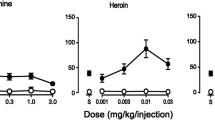Abstract
Each of five dogs that had been trained to chronically self-administer IV morphine was tested with changes in the morphine dose from the baseline dose (1 mg/kg/infusion) to 0.125, 0.5, or 2 mg/kg/infusion, and with passive administration of the usual daily morphine intake while either continuing the morphine self-administration at the baseline dose or changing the self-administered solution to saline. Each treatment lasted 5 weeks. Results indicated that there is a significant negative regression of response on dose, and chronic self-administration of morphine is not entirely accounted for by a need to avoid abstinence or to obtain a direct drug effect. A third element, which may be an acquired need to obtain a response-contingent drug effect, is necessary to account for the chronic self-administration of morphine by the dog.
Similar content being viewed by others
References
Dole VP, Nyswander ME, Kreek MJ (1966) Narcotic blockade. Arch Intern Med 118:304–309
Griffiths RR, Wurster RM, Brady JV (1976) Discrete-trial choice procedure: Effects of naloxone and methadone on choice between food and heroin. Pharmacol Rev 27:357–365
Hoffmeister F, Goldberg SR (1973) A comparison of chlorpromazine, imipramine, morphine and d-amphetamine self-administration in cocaine-dependent rhesus monkeys. J Pharmacol Exp Ther 187:8–14
Hoffmeister F, Schlichting UU (1972) Reinforcing properties of some opiates and opioids in rhesus monkeys with histories of cocaine and codeine self-administration. Psychopharmacologia 23:55–74
Jones BE, Prada JA (1973) Relapse to morphine use in dogs. Psychopharmacologia 30:1–12
Jones BE, Prada JA (1977) Effects of methadone and morphine maintenance on drug-seeking behavior in the dog. Psychopharmacology 54:109–112
Pickens R, Thompson T (1968) Cocaine-reinforced behavior in rats: Effects of reinforcement magnitude and fixed-ratio size. J Pharmacol Exp Ther 161:122–129
Risner ME, Jones BE (1976) Role of noradrenergic and dopaminergic processes in amphetamine self-administration. Pharmacol Biochem Behav 5:477–482
Schlichting UU, Goldberg SR, Wuttke W, Hoffmeister F (1971) d-Amphetamine self-administration by rhesus monkeys with different self-administration histories. Proceedings of the European Society for the Study of Drug Toxicity. Excerpta Med Int Congr Ser 12:60–67
Smith SG, Werner TE, Davis WM (1976) Effect of unit dose and route of administration on self-administration of morphine. Psychopharmacology 50:103–105
Stolerman IP, Kumar R (1970) Preferences for morphine in rats: Validation of an experimental model of dependence. Psychopharmacologia 17:137–150
Thompson T, Schuster CR (1964) Morphine self-administration, food-reinforced, and avoidance behaviors in rhesus monkeys. Psychopharmacologia 5:87–94
Weeks JR (1962) Experimental morphine addiction: Method for automatic intravenous injections in unrestrained rats. Science 138:143–144
Weeks JR, Collins RJ (1964) Factors affecting voluntary morphine intake in self-maintained addicted rats. Psychopharmacologia 6:267–279
Weeks JR, Collins RJ (1979) Dose and physical dependence as factors in the self-administration of morphine by rats. Psychopharmacology 65:171–177
Wikler A (1965) Conditioning factors in opiate addiction and relapse. In: Wilner DM, Kassebaum GG (eds) Narcotics. McGraw Hill. New York, pp 85–100
Wikler A (1973) Dynamics of drug dependence: Implications of a conditioning theory for research and treatment. Arch Gen Psychiatry 28:611–616
Wikler A (1974) Requirements for extinction of relapse-facilitating variables and for rehabilitation in a narcotic-antagonist treatment program. Adv Biochem Psychopharmacol 8:399–414
Woods JH, Schuster CR (1968) Reinforcement properties of morphine, cocaine and SPA as a function of unit dose. Int J Addict 3:231–237
Yanagita T, Deneau GA, Seevers MH (1963) Physical dependence to opiates in the monkey, with demonstration. Presented at the 25th meeting, Committee on Drug Addiction and Narcotics, National Research Council, National Academy of Sciences, Ann Arbor, Michigan, 16 February, 1963
Author information
Authors and Affiliations
Rights and permissions
About this article
Cite this article
Jones, B.E., Prada, J.A. Characteristics of chronic self-administration of morphine by dogs. Psychopharmacology 74, 204–207 (1981). https://doi.org/10.1007/BF00427094
Received:
Accepted:
Issue Date:
DOI: https://doi.org/10.1007/BF00427094




